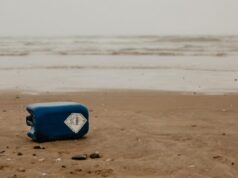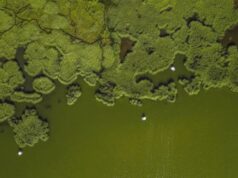Heliofungia behaviour as it’s bleaching, captured by Brett Lewis and Dr Luke Nothdurft. Credit: Queensland University of Technology
Coral researchers have for the first time captured the specific behaviour of a coral as it’s bleaching.
The team from QUT in Australia used a clever combination of microscope, digital camera and smart tablet to record close-up, detailed time-lapse videos of a coral species’ physical reaction to heat stress, showing evidence for the first time that it employs pulsed inflation.
To simulate rising sea surface temperatures, researchers Brett Lewis and Dr Luke Nothdurft from QUT’s marine facility in the School of Earth, Environmental and Biological Sciences placed solitary corals, Heliofungia actiniformis, into controlled aquaria, before heating the water up.
Their resulting videos, described in the peer-reviewed Coral Reefs, show the unhappy corals belching Symbiodinium, tiny algae cells that live within coral tissue and give corals their vibrant colours.
“What’s really interesting is just how quickly and violently the coral forcefully evicted its resident symbionts,” said Mr Lewis, from QUT’s Science and Engineering Faculty.
Find your dream job in the space industry. Check our Space Job Board »
“The H. actiniformis began ejecting the symbionts within the first two hours of us raising the water temperature of the system.”
Mr Lewis said previous studied had shown H. actiniformis was one of the very few corals on the Great Barrier Reef considered to be relatively resilient to bleaching, even as neighbouring species suffered the full effects.
“Our observations suggest this resilience could be due to the rapid expulsion of the coral’s algal symbionts during thermal stress, and could very well increase H. actiniformis’s chance of survival during abnormally high sea temperatures.”
During the experiments, the team raised the water temperature in a 10-litre aquarium system from 26oC to 32oC over 12 hours, where it remained for up to eight days.
While scientists have known for some time that coral bleaching occurs when the relationship between the coral and their Symbiodinium breaks down as ocean temperatures rise, the QUT team’s time-lapse videos show for the first time how this coral removes the algae.
“Our H. actiniformis used a pulsed inflation to expel Symbiodinium over time (seen as greenish plumes in the video) – inflating their bodies to as much as 340 per cent of their normal size before suddenly and violently contracting and ejecting Symbiodinium through their oral openings over the four to to eight day duration of the experiments” Dr Nothdurft said.
Dr Nothdurft said reef-building corals and their algal Symbiodinium had evolved to form a mutually-beneficial relationship.
“Coral provide Symbiodinium with protection and surface area for photosynthesis, while the excess sugars created by the algae supply the majority of the coral’s daily food requirements,” he said.
He said expulsion of the algae removed the pigment from the corals tissue, rendering them white or transparent, referred to as coral bleaching. If environmental conditions return to normal quickly enough, some corals may regain their Symbiodinium and associated colour.
“If the Symbiodinium is removed from the host and does not recolonise quickly, the corals can die. .
“Mass coral bleaching events are a concern for scientists globally with recent events on the Great Barrier Reef highlighting the threat of elevated water temperatures to the heath of reef ecosystems.”
Source: Queensland University of Technology
Research Reference:
B. M. Lewis et al. Expulsion of Symbiodinium by pulsed inflation under hyperthermal stress in Heliofungia actiniformis, Coral Reefs (2016). DOI: 10.1007/s00338-016-1473-5











